An Economic Lifeline? How Remittances From the US Impact Mexico’s Economy

Table of Contents
Author(s)
Share this Publication
- Print This Publication
- Cite This Publication Copy Citation
Jose Ivan Sanchez-Rodriguez, "An Economic Lifeline? How Remittances From the US Impact Mexico’s Economy" (Houston: Rice University's Baker Institute for Public Policy, November 13, 2023), https://doi.org/10.25613/RDAS-MX20.
Introduction
When international migrants, primarily workers, send money to their family members in their home countries, these transfers are known as remittances. In recent years, remittances have grown substantially, becoming one of the main contributors to the economies of recipient countries. By the end of 2023, remittances sent by workers to low- and middle-income countries are expected to reach approximately $639 trillion dollars — about 78% of total remittances across the globe.[1] The main recipient countries include India (12.6% of the total sent), Mexico (7.5%), China (6.4%), and the Philippines (4.8%).[2] The largest source of remittances is the United States, with more than 25% of all transfers; Saudi Arabia is second with 6.6%.[3] Given the large population of Mexican immigrants — both documented and undocumented — living in the United States, it is unsurprising that Mexico receives a high percentage of the remittances from the U.S.
For low- to middle-income countries, remittances have become so important that in many cases they have surpassed foreign direct investment (FDI) in generating economic growth and reducing poverty. However, the extent to which remittances drive this growth depends on how recipient households use them. In many cases, it is hard to determine exactly how remittances contribute to economic growth in a country, given the complexity of their use.[4] Thus, fully depending on remittances to drive economic growth should be avoided, especially since these resources are not generated by the internal economic policies of recipient countries. Moreover, workers who left their countries and send money home are now generating economic growth for another nation — meaning their home country has lost a valuable source of human capital.
Remittances should instead be considered a supplementary — but not essential — variable in the economic growth of the receiving country. Mexican workers in the U.S., for example, not only support the Mexican economy through remittances, but they also contribute to the American economy through their work in essential sectors such as agriculture, food processing, construction, health care, etc. In addition, these workers are consumers and pay federal, local, and state taxes, thereby generating economic growth in the United States.[5]
To determine how remittances impact an economy, it is important to know how recipient households use the resources they are sent. Remittances can be used to purchase goods and services, save, or invest in physical or human capital. When remittances are used to purchase goods and services, this increased consumption has a positive impact on aggregate demand and generates economic growth. And when used to invest in human capital (e.g., in education), remittances can contribute to economic development in the medium and long terms.
However, in low- and middle-income countries, remittances seem to be largely used for consumption and not for investment. In general, recipient households are in the poorest deciles and therefore primarily use the money they receive to alleviate their poverty. In fact, past studies have shown that remittances do help alleviate poverty in recipient countries, but believing that remittances alone can eradicate poverty is a mistake. [6]
Understanding the impact of remittances in the short and long terms is also complex. In theory, if remittances help households increase consumption, this would lead to economic growth in the short term, which can generate greater growth in the long term. The idea is that to satisfy the greater aggregate demand, companies would have to increase their production capacity. Although this makes sense theoretically, it doesn’t always work in practice due to the interplay of other variables. In fact, some research shows that remittances contribute little to economic growth in receiving countries and may have no impact on economic growth in the long term.[7]
However, when analyzing groups of countries that receive the greatest number of remittances — as was done by Mohammad Salahuddin and Jeff Gow (2015) with Bangladesh, India, Pakistan, and the Philippines — a strong positive relationship was confirmed between remittances and economic growth in the long term, but not in the short term.[8] This would imply that low- and middle-income countries can indeed experience long-term benefits from remittances.
Based on these findings and considering that Mexico is also a low- to middle-income country, this paper explores how remittances from the U.S. have impacted Mexico’s economy in both the short and long terms. Have remittances generated economic growth, and should Mexico continue to rely on them in the future?
To analyze the complex relationship between remittances and economic growth, this paper first looks at the evolution and trends of remittances in recent years at the national, state, and municipal levels in Mexico, comparing their numbers before and after the COVID-19 pandemic. Second, it looks at the characteristics of Mexican households receiving remittances. Given that the vast majority of remittances are sent from the United States, the U.S. wages of Mexican immigrant workers and the relationship between remittances and their wages are then discussed. Finally, the paper explores the overall impact of remittances on economic growth and development in Mexico, as well as the prospects for the flow of remittances in the coming years.
Remittances at the National, State, and Municipal Levels in Recent Years
This section analyzes recent trends in remittances at the national, state, and municipal levels in Mexico and their significance for its economy during the COVID-19 pandemic.[9]
Total remittances sent to Mexico have grown exponentially since 2013 (Figure 1), and their levels have not decreased since then. In fact, it was predicted that remittances would decline worldwide due to the pandemic, but this was not the case. In fact, in Mexico, remittances reached historic highs.
In 2022, remittances to Mexico reached $58.497 billion, according to data from the Banco de Mexico (BANXICO), despite a complicated economic environment with high inflation and high interest rates set by the central bank. This represents a 13.4% increase over 2021, and a 162.3% increase since 2013. The highest annual growth in remittances since 2013 was 27% in 2021 as compared to 2020, partly motivated by a reactivation of labor markets in the U.S. (Figure 2). However, given the bleak global economic outlook in the coming years, remittances are expected to plateau or grow at decreasing rates. But in Mexico, if there is a lower rate of economic growth, low- and extremely low-income households may send more migrants to the U.S. in search of work, causing remittances to continue growing instead. Security conditions in Mexico could also contribute to increased migration flows to the U.S., which could further alter the growth of remittances.
Figure 1 — Remittances, 2000–22 (Dollars)
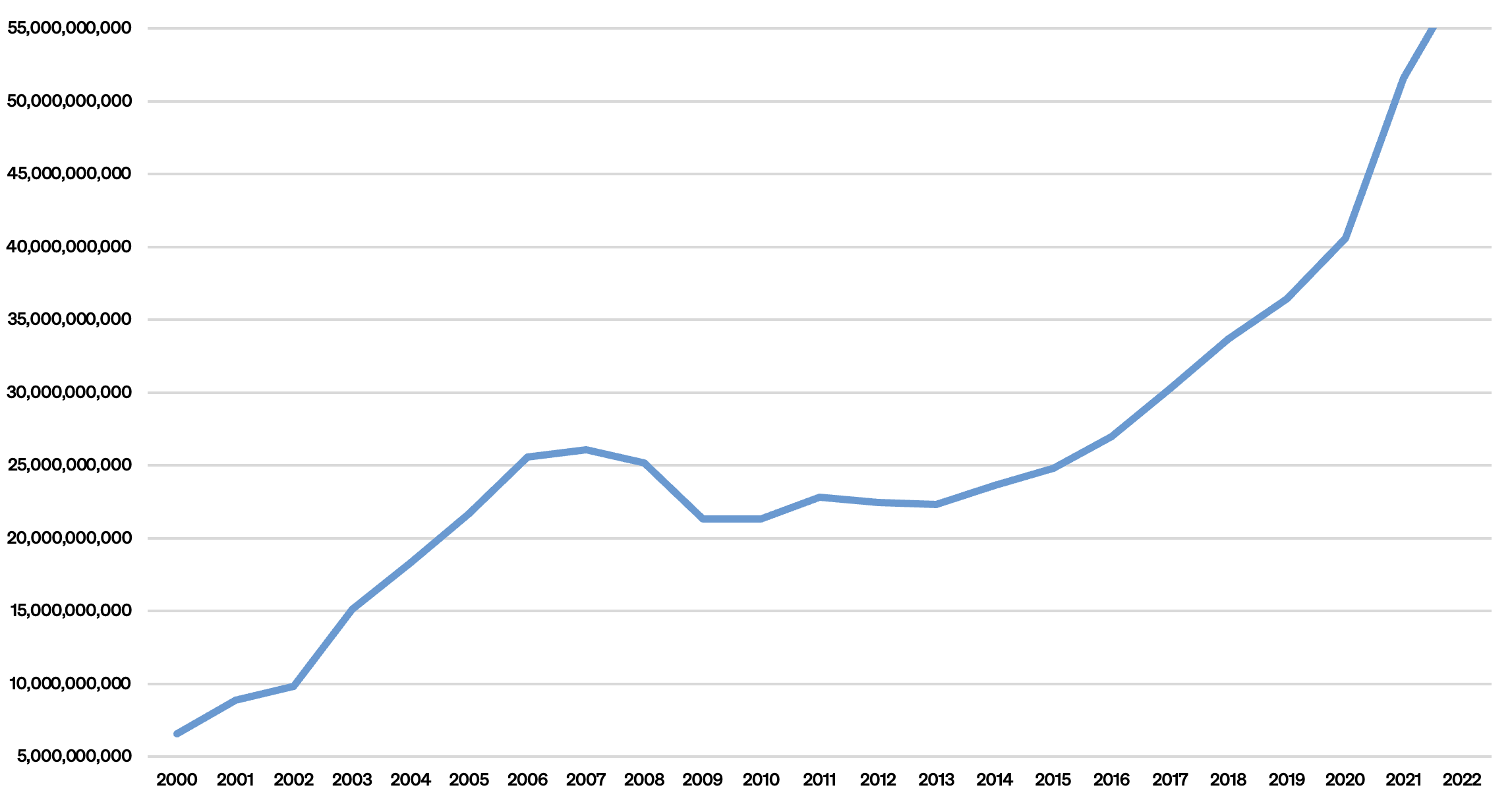
Figure 2 — Growth Rate of Remittances, 2000–22
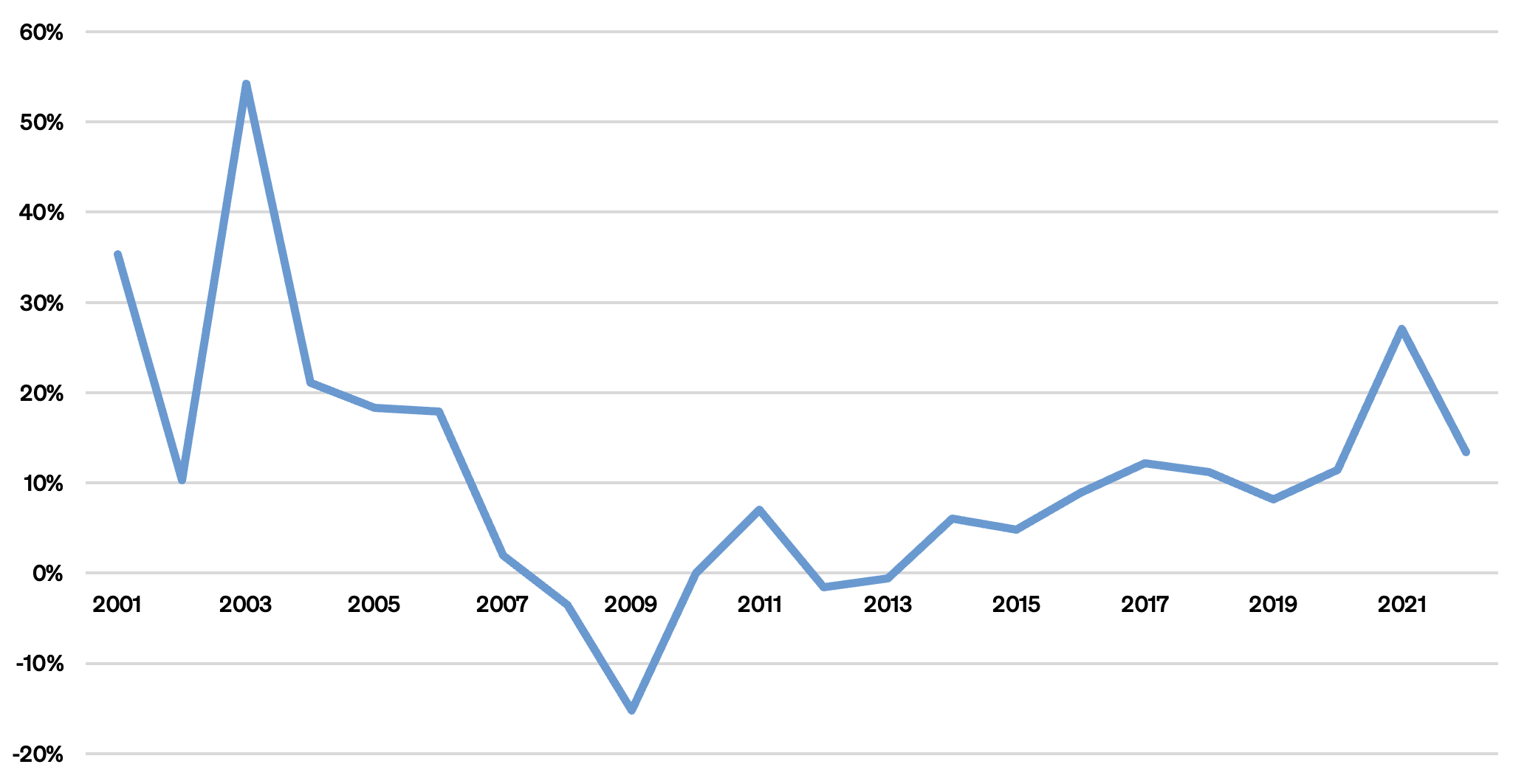
If remittances are viewed as a percentage of the gross domestic product (GDP) in Mexico, this percentage has also been growing considerably since 2013, though in the last few years it has remained constant. In 2022, remittances represented approximately 4.1% of the national GDP, an increase of 2.4 percentage points as compared to 2013 (Figure 3). These numbers show the importance of remittances in the Mexican economy, particularly in the last decade.
Remittances have, in fact, surpassed foreign direct investment in Mexico, mainly since 2018 (Figure 3). This places remittances as the second largest source of income in the country, falling only below automotive industry exports. Remittances also recently surpassed Mexican oil exports, suggesting that the Mexican economy depends heavily on the transfer of these funds. Without them, the nation’s recent economic contraction, which started with the election of President Andrés Manuel López Obrador in 2018, may have been greater — particularly in 2020, when there was a GDP drop of around 8%.
Figure 3 — Income from Remittances and FDI as a percentage of GDP, 2010–22
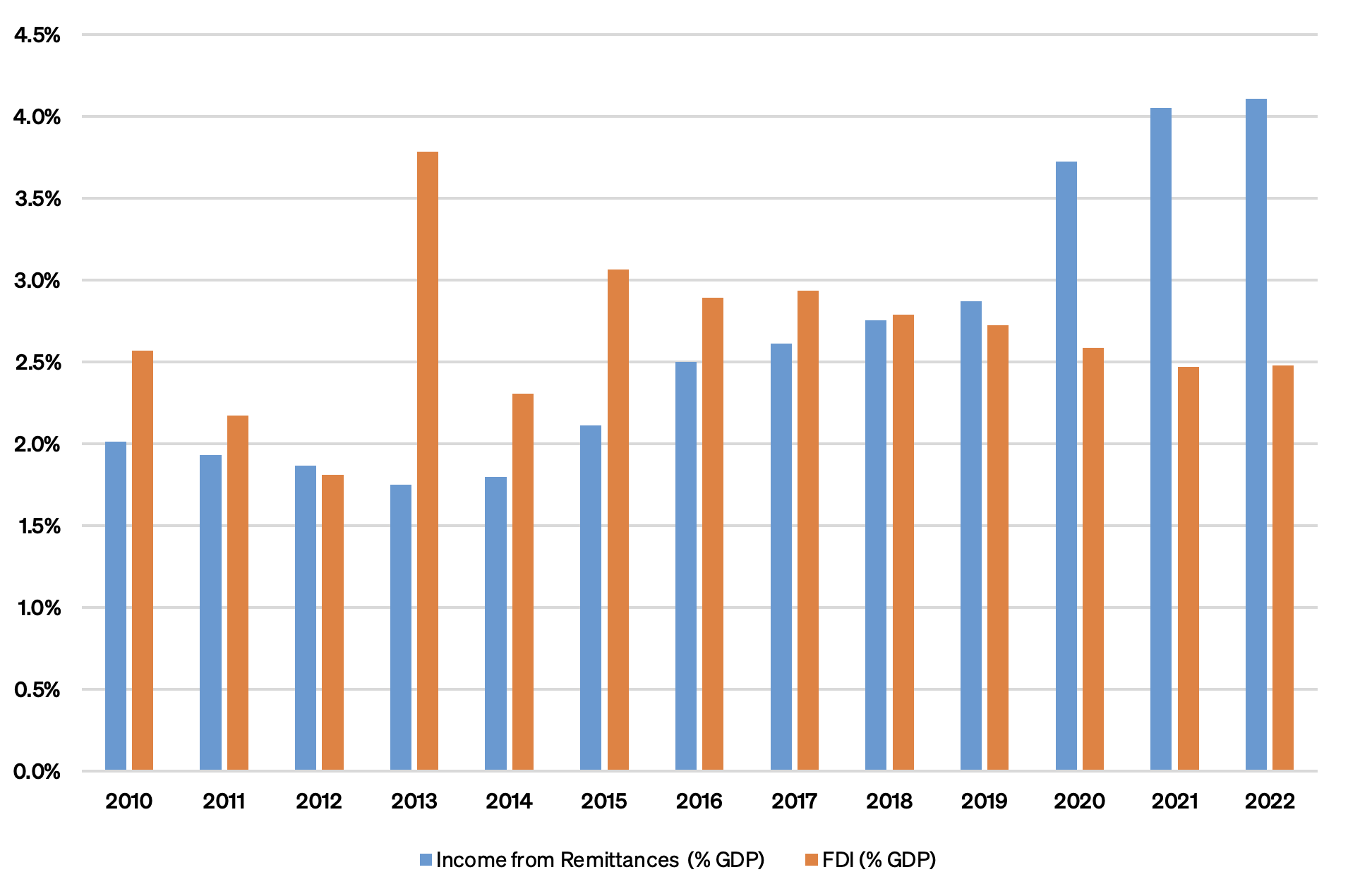
Along with the increase in the dollar amount of remittances sent to Mexico, the number of individual money transfers has also risen significantly since 2013. In fact, this number rose from 76.75 million in 2013 to 149.97 million in 2022 — a 95% increase.
The most common way to send money is through electronic transfers. In recent years, this method was used for 99% of the total number of transfers. The average amount sent per month was $390 dollars (around 7,800 pesos) in 2022 — the largest amount ever and a growth of 34% compared to 2013. As a point of reference, the general minimum wage in 2022 was 172.87 pesos per day (and 260.34 pesos per day along the border), or approximately 5,258 pesos (and 7,919 pesos at the border) per month.[10] Thus, on average, remittances equate to more than the minimum income a worker in Mexico earns for his or her work per month and a little less than what workers at the border earn per month.
Remittances from the United States
The majority of remittances sent to Mexico come from the U.S., which makes sense given that 97% of total Mexican emigrants live there.[11] In recent years, the amount of money transferred from the U.S. to Mexico represented more than 95% of Mexico’s total remittances. In 2022 alone, that amount was $55,864 million. Canada falls second in terms of the number of remittances sent to Mexico, but at only 1.5%.
In 2022, the states that sent the highest number of remittances from the United States to Mexico were California with $18.432 billion (33% of the total sent) and Texas with $8,491 million (15.1% of the total sent). It is worth mentioning that these states have, for years, sent the most remittances to Mexico — not a surprising fact given that they are the two states with the largest Mexican immigrant population. California has a Mexican immigrant population of approximately of 3.9 million (36% of total immigrants from Mexico), while Texas has 2.4 million (22% of total immigrants from Mexico).[12]
Other states are catching up. One state that has seen a significant increase in the number of remittances is Minnesota. Minnesota went from sending only $420 million dollars to Mexico in 2013, 1.9% of the total, to $4,708 million in 2022, 8.4% of the total. That is, transfers from this state grew by 1,020% from 2013 to 2022 despite the fact that its Mexican immigrant population is only 58,000 (1% of the total immigrants from Mexico). The factors generating this large increase in remittances from Minnesota warrant further investigation. A possible hypothesis is that there has been a considerable increase in temporary immigrant workers in its agricultural sector in recent years. A more pessimistic hypothesis is that these resources come from criminal groups that use remittances to launder money.
The states that sent the lowest number of remittances in 2022 were Maine (0.1%), Rhode Island (0.04%), and Vermont (0.02%).
Figure 4 — States with the Highest Number of Remittances Sent from the United States, 2013 and 2022 (Millions of Dollars)
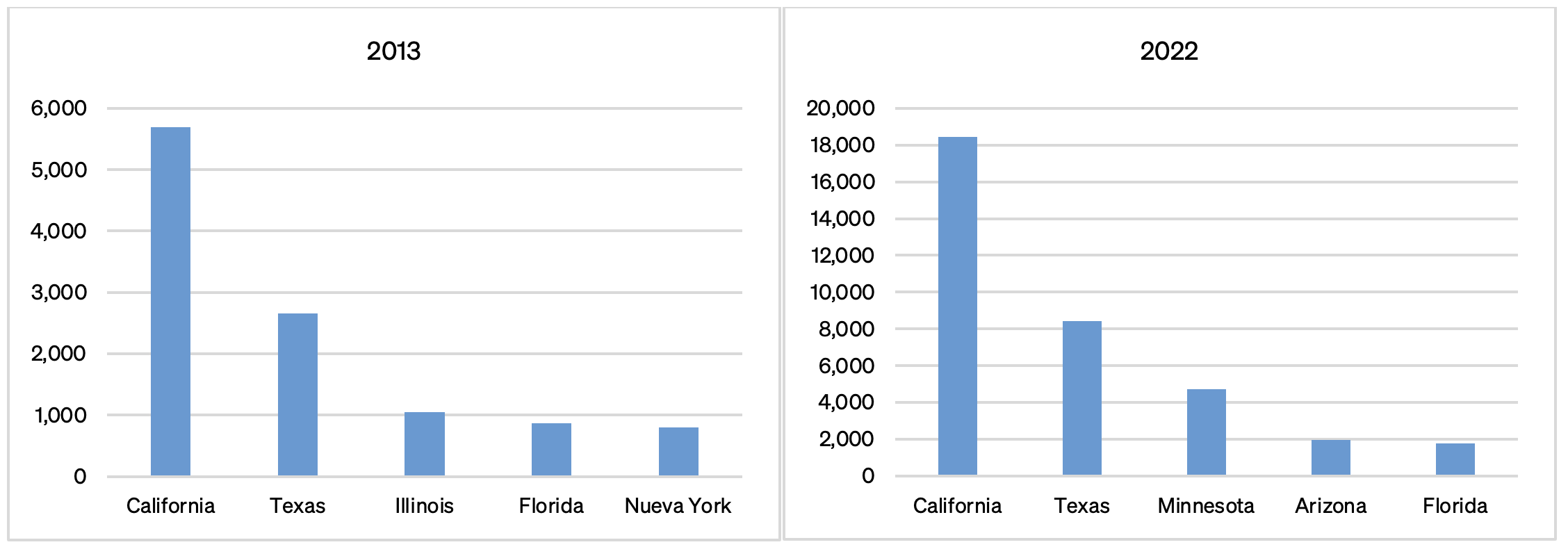
Remittances Received in Mexico by States and Municipalities
States
When examining the 32 states in Mexico and the distribution of total remittances by state, there is a correlation among states that have sent more Mexican workers abroad and the destination of remittances. Zacatecas, Guanajuato, Michoacán, and Oaxaca are the states with the highest number of emigrants to the United States in recent years. It should be expected that these workers send money to their relatives who reside in those states.[13] Indeed, of these states, Michoacán is the state that receives the highest number of remittances with a total of $5,285 million in 2022. Michoacán has ranked first and second among the states that receive the most remittances in the last decade (Figure 5). Guanajuato has ranked second and third in terms of the most remittances received in the last decade, and in 2022, it received a total of $5,059 million. Oaxaca obtained about $2,903 million in 2022 and has occupied sixth to eighth place in recent years. Zacatecas totaled $1,724 million and has ranked between eleventh and thirteenth place among the states that have received the most remittances in the last decade. Finally, since 2020, Jalisco has become the state with the highest number of remittances received with a total of $5,402 million.
It’s worth mentioning that the gap between the first three places has recently been increasing with respect to the other states. Today, Jalisco, Michoacán, and Guanajuato are the states that receive the most remittances in absolute terms. On the other hand, the states that receive the least remittances include Tabasco, Yucatán, Quintana Roo, Tlaxcala, Baja California Sur, and Campeche with an average of approximately $328 million dollars in 2022.
Figure 5 — States that Receive the Highest Number of Remittances in Mexico, 2010–22 (Millions of Dollars)
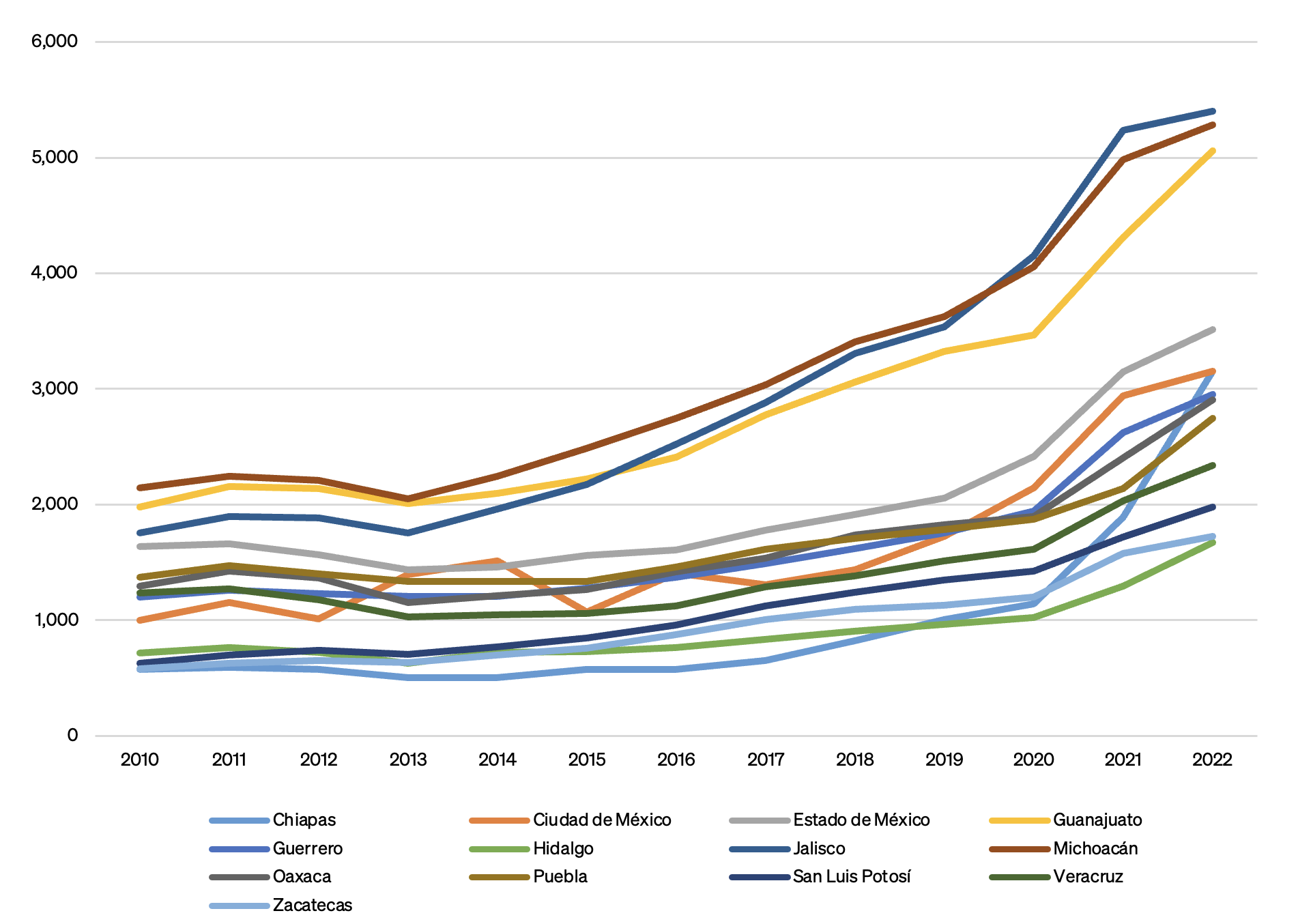
When looking at the states that receive the most remittances, it is important to analyze the relative value that these states have when comparing their remittances with their total production or GDP. This helps verify the impact of these resources on these states’ economies as well as their possible dependence on remittances.
By establishing the level of remittances that a state receives as a percentage of its real GDP,[14] we can see that, on average, this percentage has increased from 4.1% in 2010 to 8.3% in 2021. This indicates the importance of remittances for these state economies, especially considering that remittances have increased considerably in the last few years.
Having analyzed the remittances received by Jalisco, Michoacán, and Guanajuato in relative terms to their respective GDPs, we can see that Michoacán is consistently at the top of the list. In 2010, this percentage was nearly 13%, and in 2021, it increased to 24.5% (Figure 6). Guerrero follows behind Michoacán with 11.3% in 2010 and 23.1% in 2021; Zacatecas increased from 8% to 20.9% in the same period; and Oaxaca’s percentage grew from 11.4% to 19.3%. For Jalisco, this percentage went from 3.8% to 8.8% between 2010 and 2021, and Guanajuato’s percentage rose from 7.7% in 2010 to 12.6% in 2021. The states that have had the lowest average percentage in the last few years include Mexico City (1.1%), Nuevo León (1.1%), Baja California Sur (1.0%), Tabasco (0.7%), and Campeche (0.3%). Therefore, it seems that these last states do not depend as heavily on the resources that are sent by Mexican workers in the U.S.
Figure 6 — States that Receive the Highest Number or Remittances as a Percentage of GDP in Mexico, 2010–22
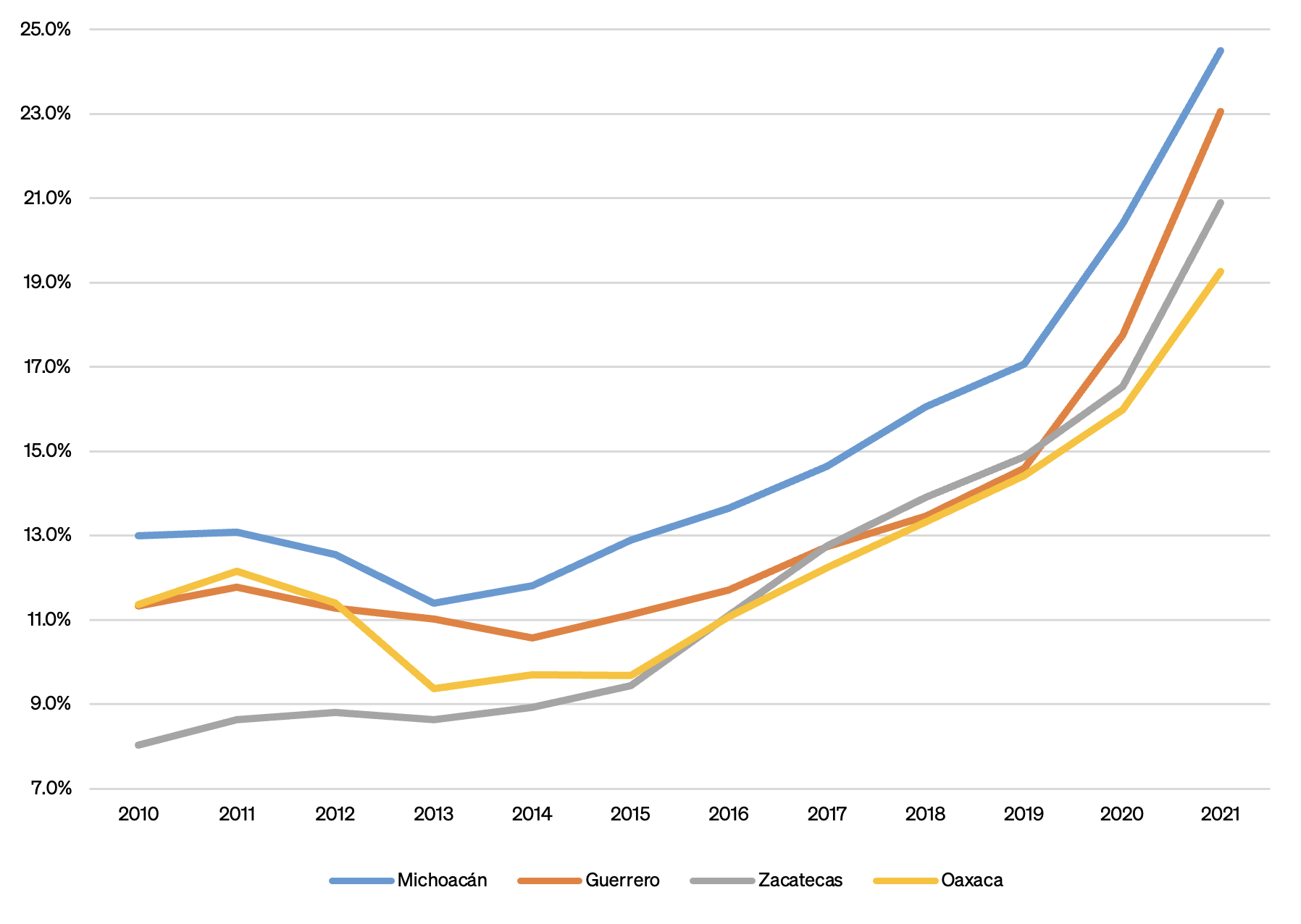
Another way to test the importance of remittances on the various Mexican states is by comparing them with each state’s public income. This analysis shows that remittances have, in fact, a significant weight in relation to public income. For example, remittances received by Michoacán exceeded public income, which totaled 84,016 million pesos or approximately $4.199 billion in 2021 (Table 1). The income from remittances that this state obtained was approximately $4.984 billion. That is, each dollar of public income was matched by $1.19 in remittances (Figure 7). This is the only state in which remittances are higher than public income (119%).
Other states where remittances were very important with respect to their state income in 2021 were Zacatecas (92.8%), Guanajuato (90.9%), Jalisco (80.4%), and Guerrero (73.7%). In total, there are 13 states where remittances represented more than 50% of public income. On average, this percentage represents 45.3% of all states. This is a high percentage, and in recent years, it’s been growing even higher. For the states with the lowest percentage, Mexico City stands out, likely because public income is not proportionally as high. There, remittances represented 26% of public income. Remittances were also a lower proportion of public income in Yucatán (16.8%), Quintana Roo (16.8%), Baja California Sur (14.5%), Tabasco (13.7%), and Campeche (12.7%).
Table 1 — State Public Income and Remittances in Mexico, 2021 (Millions of Dollars)
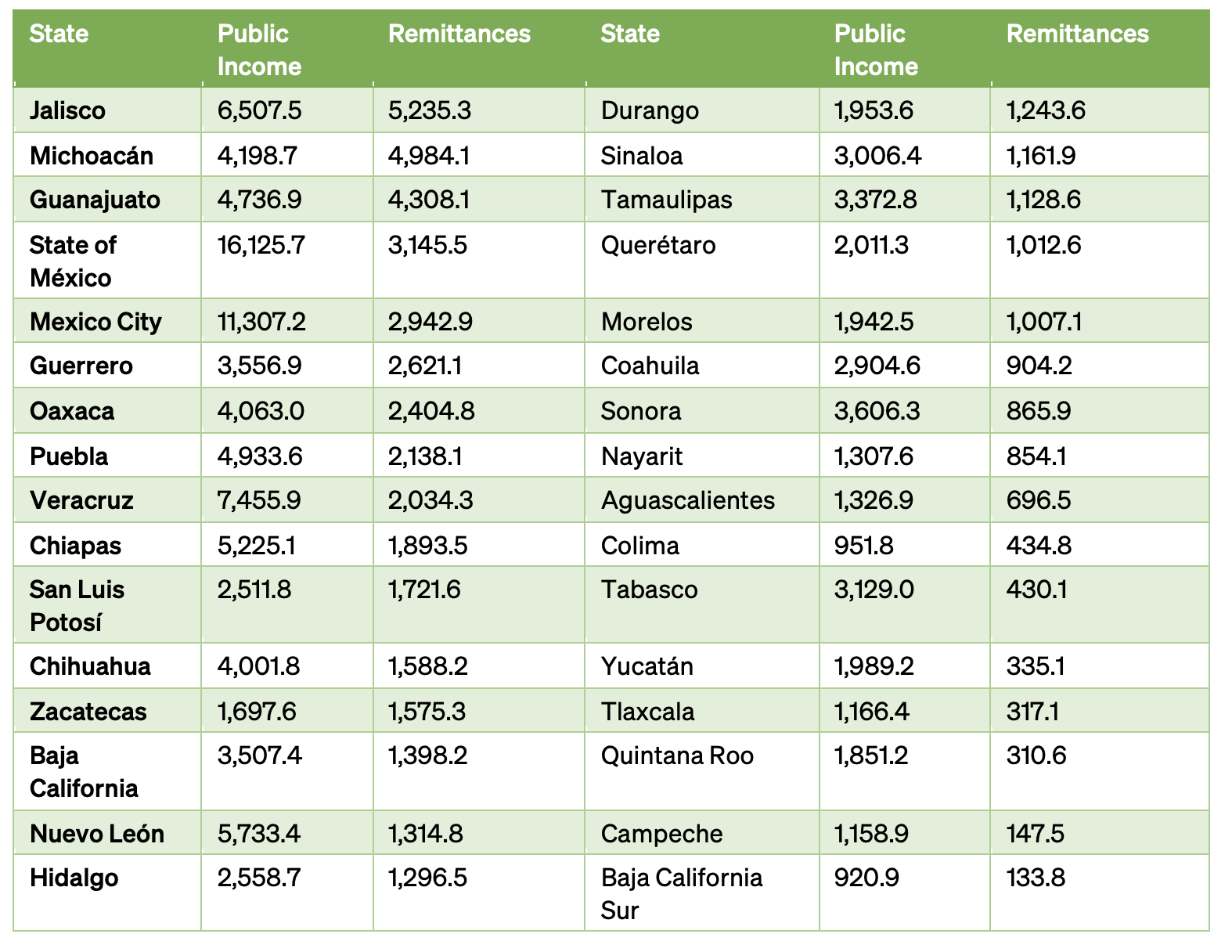
Figure 7 — Remittances by State (% Public income), 2021
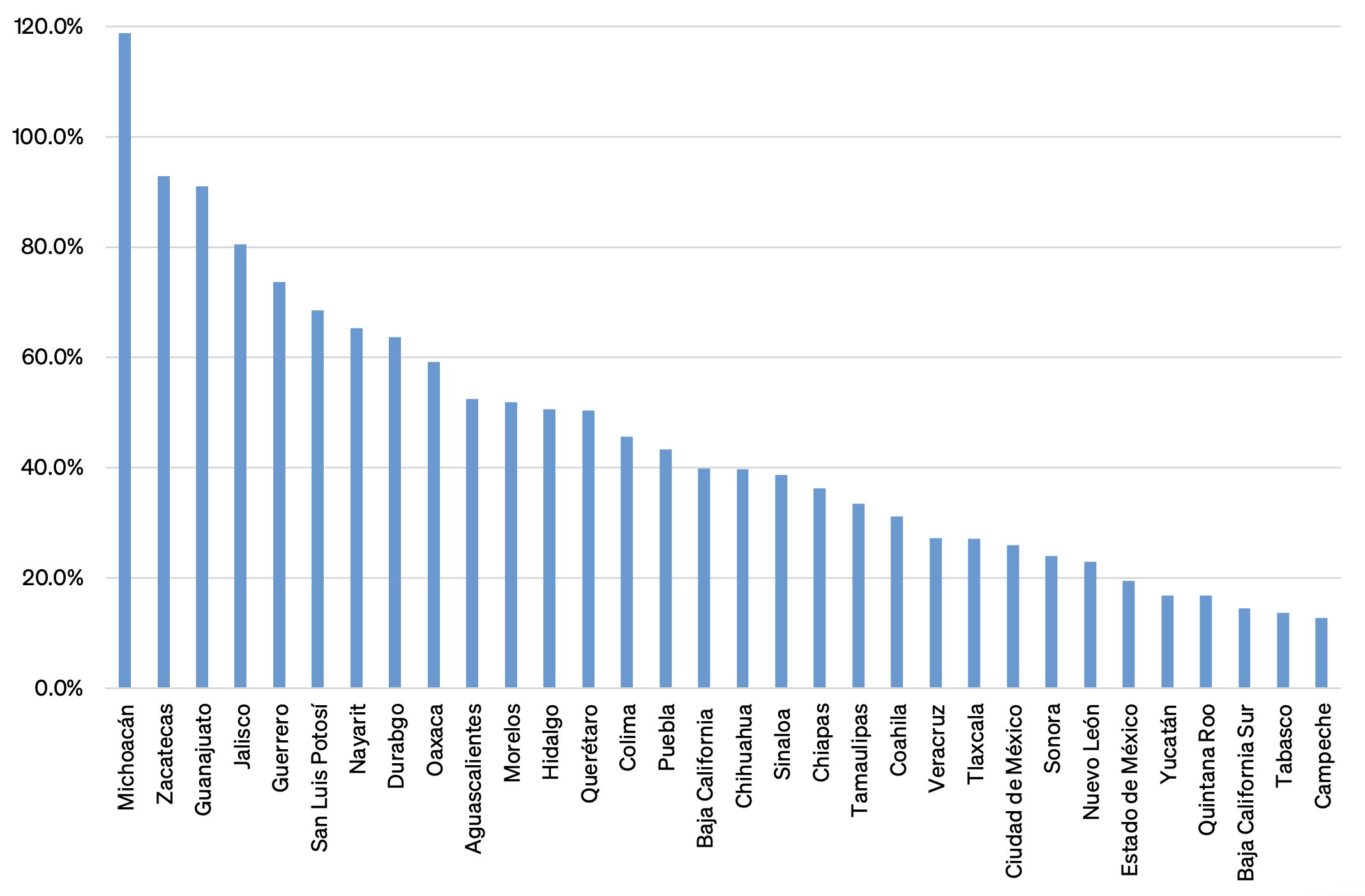
Municipalities
Mexico has 32 states and 2,471 municipalities.[15] The state with the largest number of municipalities is Oaxaca with 570, followed by Puebla with 217, and Veracruz with 212. The state with the smallest number of municipalities is Baja California Sur with five, followed by Baja California with five, and Colima with 10.[16]
The municipality of Tijuana in the state of Baja California has been the top receiver of remittances since 2015. In 2022, the Tijuana municipality received $753 million (52.7% of the total received by the state of Baja California), a growth of 95.4% from 2015 to 2022.
Other municipalities that are also at the top of receiving remittances include Guadalajara, Jalisco with $631.5 million (11.7% of the total received by Jalisco); Morelia, Michoacán with $597.3 million (11.3% of the total received by Michoacán); León, Guanajuato with $535.5 million (10.6% of the total received by Guanajuato); and Puebla, Puebla with $519.7 million (18.9% of the total received by the state of Puebla) (Table 2).
Municipalities that receive the most remittances compared to the total of their states include Tijuana, Baja California (52.7% in 2022) and Aguascalientes, Aguascalientes (59.9% in 2022). These municipalities have maintained this trend in recent years. However, it is pertinent to mention that these municipalities belong to states that have a small number of municipalities — only five in the case of Baja California and 11 for Aguascalientes. In 2022, the five municipalities that received the most remittances totaled around $3.037 billion (5.2% of the total sent to Mexico).
Table 2 — Municipalities that Receive the Largest Number of Remittances in Mexico, 2016–22 (Millions of Dollars)
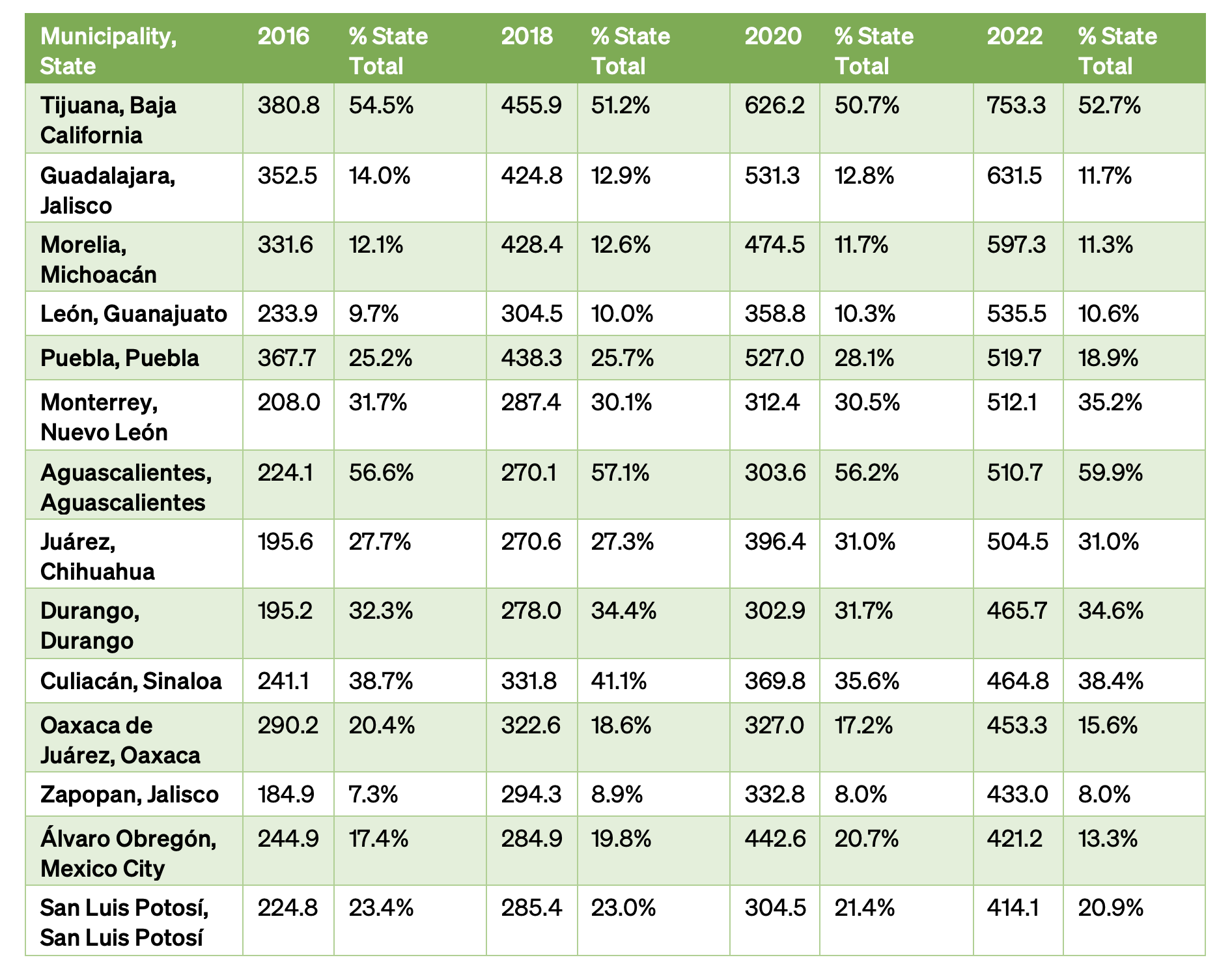
A municipality that has become a major recipient of remittances in recent years is San Cristóbal de las Casas, Chiapas. This municipality is not in the previous table as it was not until 2022 that it became one of the most important recipients of remittances at the national level. This municipality went from receiving $51.9 million dollars in 2013 to $540.8 million dollars in 2022 — a growth of 942% in that period. This meant that Chiapas went from 19th place out of 32 states in 2013 to sixth place in 2022. This spike in remittances may be attributed to increased transit migration, mainly from Central America. As Central Americans travel across Mexico to reach the U.S., they often pass through Chiapas where many become stuck and are sent money from their relatives who already live in the United States to help them subsist while they continue to travel north.
Characteristics of Mexican Households That Receive Remittances
Remittances received by Mexican households have increased exponentially since 2013. Approximately 1.77 million households received remittances in 2020, corresponding to 5.1% of total households in Mexico.[17] This percentage has not changed much in recent years; in 2016 the percentage was 4.8%.[18]
What are the general characteristics of these households? Of the households receiving remittances, those with a male at the head of the household represented 54.3%, while those with a female at the helm represented 45.7%.[19] Taking into consideration their age distribution, differences can be observed between these two groups. In the case of households with a male head-of-family, his age ranged between 40 and 79 years. In the case of households with a female head-of-family, her age ranged between 40 and 69 years of age (Figure 8).
Figure 8 — Households Receiving Remittances by Gender of the Head of Household, 2020 (People)
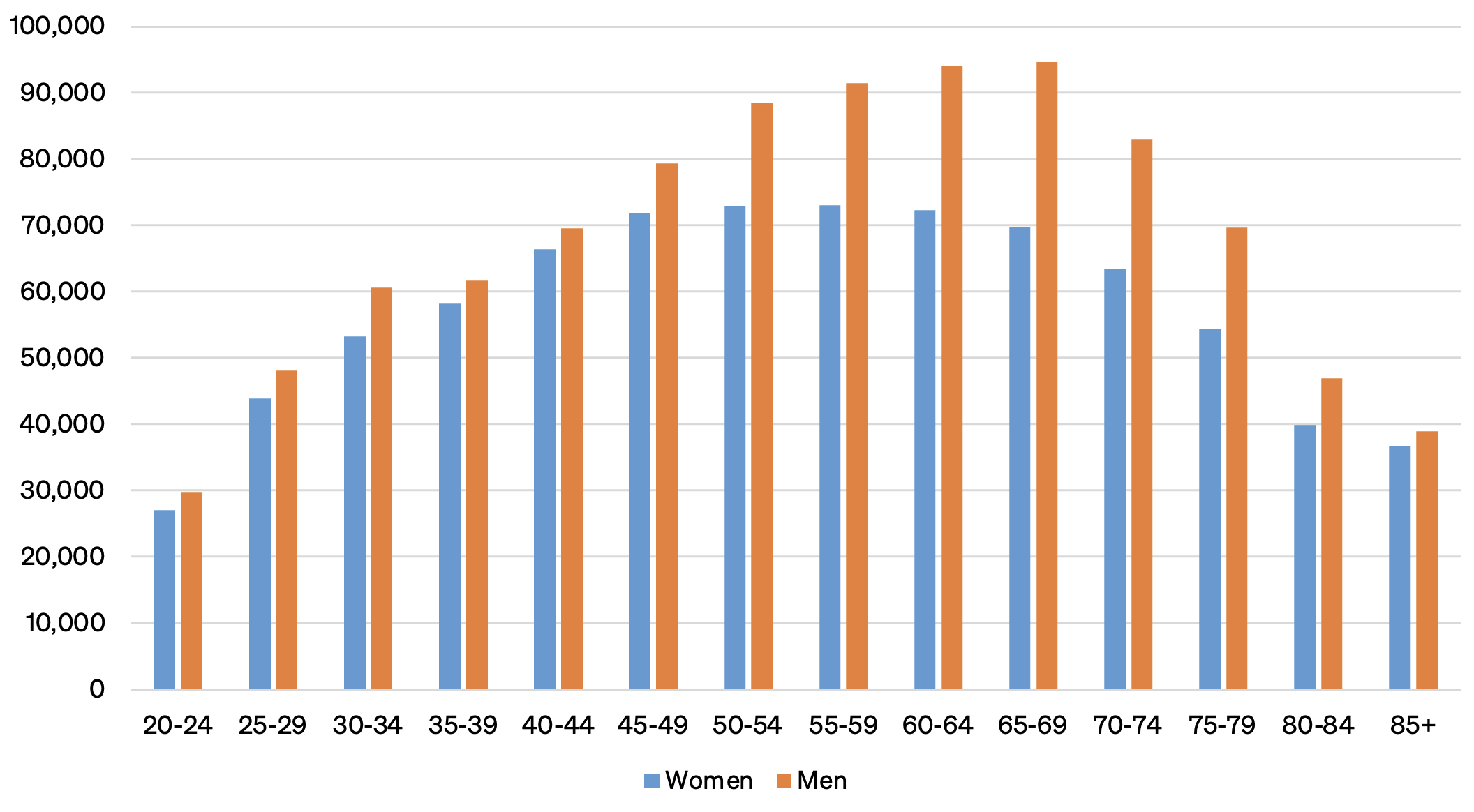
As for the average income derived from remittances, households with a male head received 14.7% more than those with a female head-of-household. For the former, the average income was 12,000 current pesos per month, while for the latter it was 10,633 pesos per month in 2020 (Figure 9).
Finally, nuclear households — i.e., those made up of only parents and children (or a couple without children) — received the majority of remittances in 49% of instances.[20]
Figure 9 — Average Monthly Income of Remittance-Receiving Households by Gender of the Head-of-Household, 2020
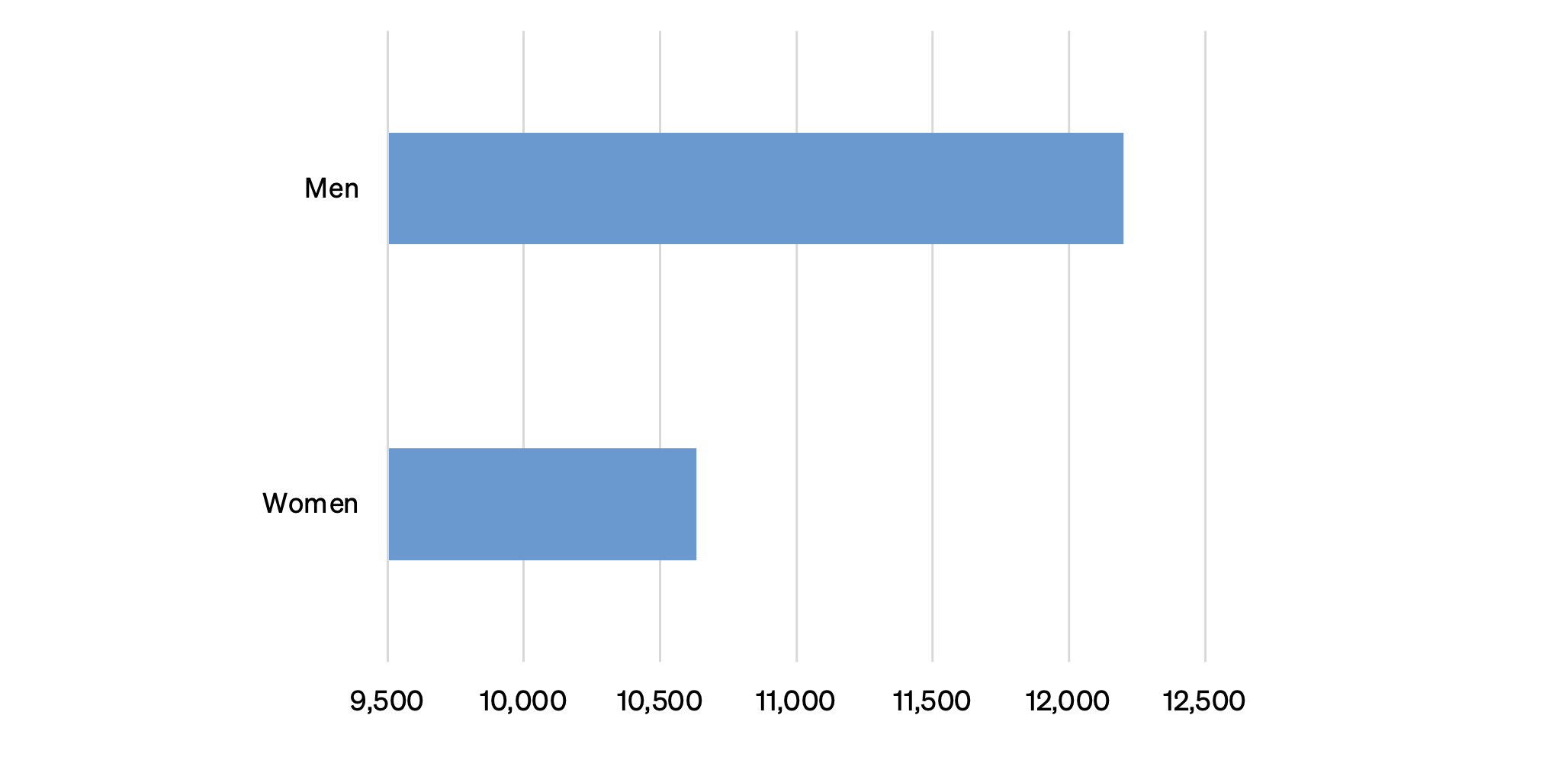
Salaries of Mexican Immigrant Workers in the United States
Mexican immigrants' main destination is the United States. Mexicans living in the U.S. represent 97% of all Mexican emigrants abroad.[21] This is due to the proximity between the two nations and the opportunities for increased income and quality of life in the U.S. Additionally, many immigrants have relatives who already live in America and encourage them to migrate northward.
Although there have always been employment opportunities in the U.S., these have increased due to severe labor shortages since 2018.[22] These shortages are generated by the aging of the American population and a decrease in birth rates. Thus, in 2021, about 10.7 million Mexico-born immigrants lived in the U.S.[23] Even so, between 2010 and 2021, this immigrant population decreased by around 9%.[24] In fact, Mexico stopped being the country with the highest number of immigrants to the U.S. in 2013 when it was surpassed by India and China.[25] This was so until the outbreak of the COVID-19 pandemic, which worsened the economic and social situation in Mexico. The López Obrador administration has also failed to develop pro-growth policies, leading many Mexicans to once again leave their homes and migrate north to the United States. The majority of Mexican immigrants (69%) live in California, Texas, Illinois, and Arizona.[26]
It is estimated that approximately 7.4 million Mexican immigrants were working in the U.S. in 2022.[27] Not surprisingly, the states where the majority of Mexicans reside (mentioned above) are also the states where the majority of Mexican immigrants work. These states have attracted 4.7 millions of these workers, or 63.6%.[28] This Mexican migrant population works mostly in the construction sector (20.9%), professional and administrative services (12.8%), manufacturing (12.6%), hospitality and recreation (12.2%), commerce (11.3%), education and health (9.8%), transportation (5.7%), and agriculture (5.3%).[29] Therefore, if it is assumed that this distribution also determines the distribution of remittances, we can surmise that for every five pesos received in remittances, one peso would come from Mexican migrants working in the construction sector.
The salary scale paid to Mexican immigrant workers in the United States increased considerably before the start of the COVID-19 pandemic. In 2020, there was a reduction in the salary scale due to a strong economic contraction generated by the closure of economies worldwide. Once economies began reopening, this salary scale began to increase, reaching a value of $319.942 billion (Figure 10).[30] Despite a tough 2020, from 2013 to 2022, the salary scale of this group of immigrants totaled $206.234 billion (64.5% of the total salary scale).
Figure 10 — Salary Mass of Mexican Immigrant Workers, 2022 (Millions of Dollars)
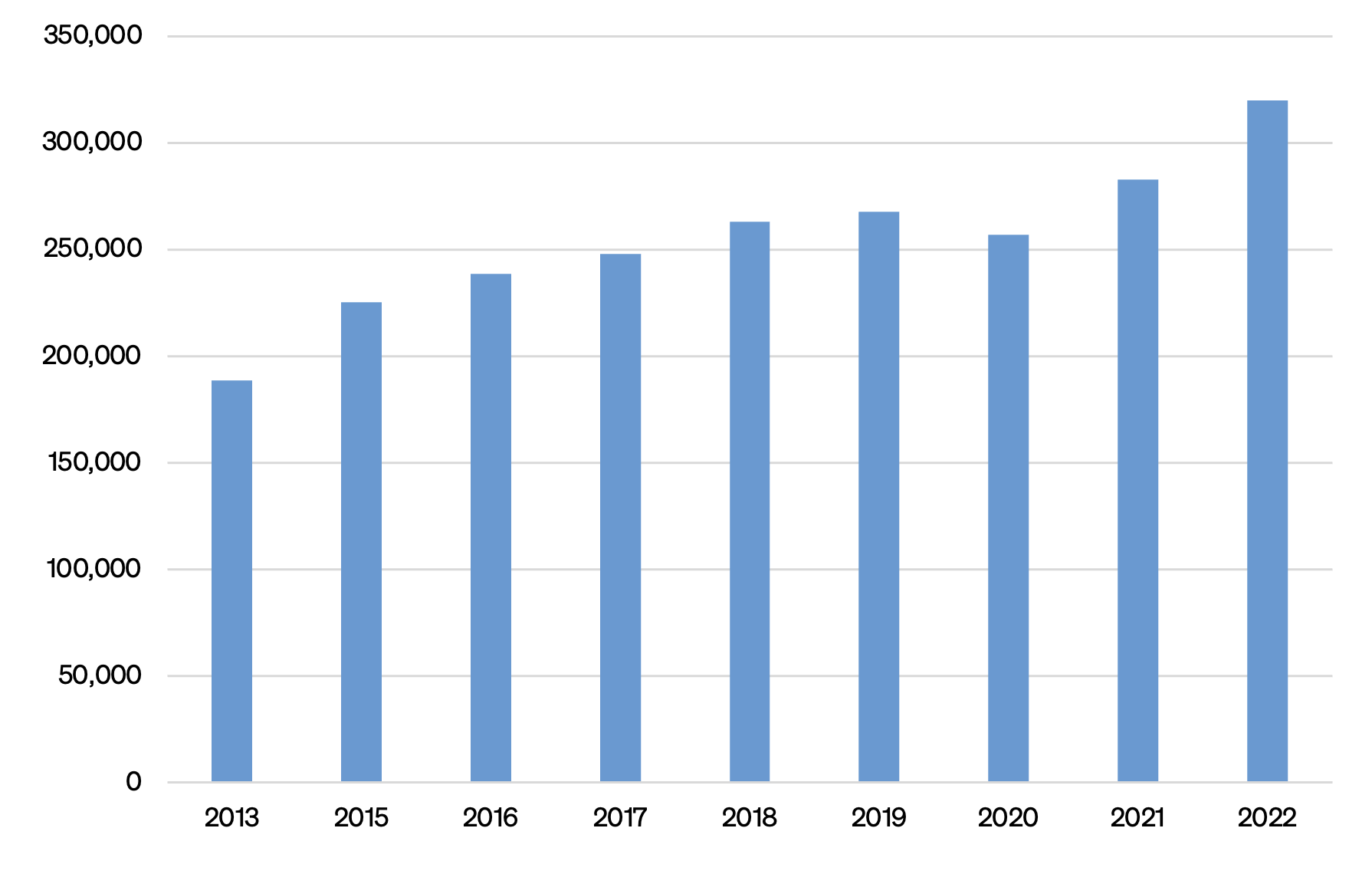
California, Texas, Illinois, and Arizona — the states with a large participation of Mexican immigrants in their economies — cumulatively represent $30.506 billion, which is 54.6% of the total remittances received by Mexico. In those states, the salary scale totaled $206.234 billion. Therefore, remittances received by these states represent 14.8% of the salary scale. At the national level, the transfer of remittances in relation to the salary scale of Mexican immigrant workers in the United States has increased considerably in recent years. This percentage was only 10.5% in 2015 and became 17.5% in 2022 (Figure 11). A key factor in ensuring that this percentage did not decrease during the COVID-19 pandemic was the financial support of the American government to all households, including Mexican immigrants.
In addition, Mexican immigrants in the U.S. may have increased the amount they send to their families due to the poor economic growth in Mexico. Mexico’s economic stagnation has affected the poorest households, which use remittances for their subsistence and basic consumption. In fact, the rate of economic growth in Mexico has been historically low, averaging around 2% from 2008 to 2018.[32] Nevertheless, this rate has decreased even further since the arrival of President López Obrador, with an average growth rate of -0.12% from 2019 to 2022. This negative value is due in part to the COVID-19 pandemic, but also to the uncertainty that the López Obrador administration has generated in the business environment — especially following the cancellation of construction plans for the new international airport intended to be built in Mexico City. The López Obrador administration also failed to develop an economic strategy that would attract investment, generate jobs, and foster greater productivity. His six-year term will end in 2024 with a very low economic growth rate — estimated at 0.6% — and high levels of poverty and inequality across Mexico.[33] Because of this, remittances will continue to be an important pillar of the economy, especially for the most vulnerable.
Figure 11 — Remittances from the United States in Relation to the Salary Mass of Mexican Immigrant Workers, 2015–22 (%)
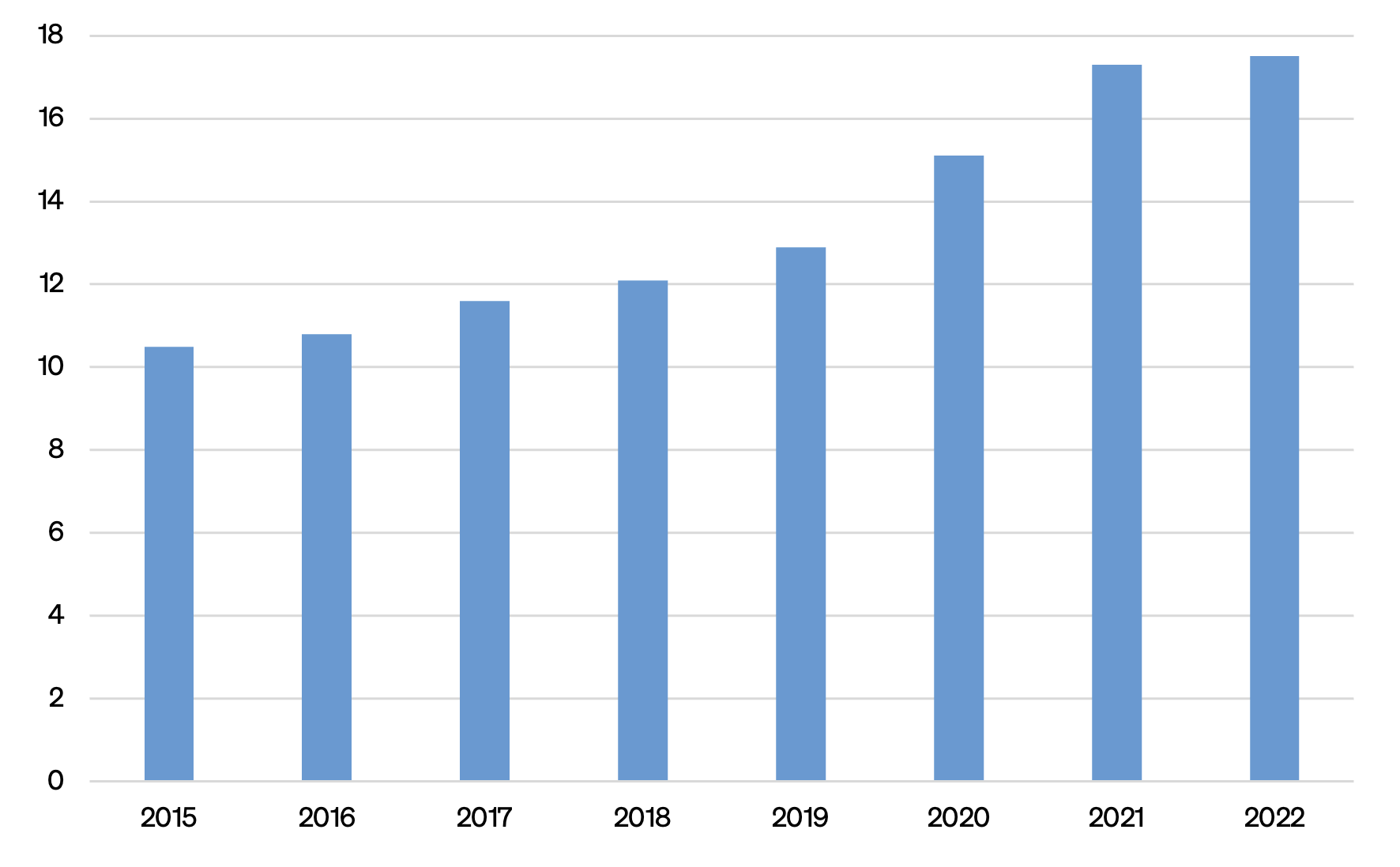
Impact of Remittances on Economic Growth and Development in Mexico: A Review of Past Literature
Considering how remittances have significantly increased in recent years, it is important to ask, have they have really led to economic growth and development in Mexico?
Remittances can generate economic growth if they are invested in physical or human capital or if they are used to finance new businesses. However, for poor households in marginalized communities, remittances are primarily used to satisfy basic needs and alleviate poverty.
Still, given the recent historic growth of remittances received in Mexico — even during the COVID-19 pandemic — it is important to look at their overall economic effects. For example, as more money flows into the country and consumption increases, it is reasonable to assume that this has generated short-term economic growth via an increase in aggregate demand. But if remittances are not used in investment or in consumption beyond subsistence, their long-term impact on economic growth could be null or very low. If this is the case, remittances would be generating an economic trap by causing economic stagnation through low growth and high emigration.[35] Thus, it is important to know how households are using the remittances they receive to identify whether or not this economic trap exists. Are households investing their resources in physical or human capital, consumption of goods and services, savings, or merely using them to survive?
Furthermore, if households use remittances to finance investments and productive activities, they can improve or soften their income over time, which is of vital importance for marginalized and rural areas in developing countries such as Mexico.[36]
The empirical evidence on remittances and economic growth varies from country to country, but most studies have found that remittances do, in fact, boost economic growth[37] and reduce poverty and inequality.[38] However, given the complexity of these relationships due to the existence of other variables, researchers have drawn a variety of different conclusions.
For example, Adolfo Barajas et al. (2009) concludes that remittances have a low impact on economic growth in recipient countries and in some cases even produce negative impacts.[39] Salahuddin and Gow (2015), who analyze some of the main countries receiving remittances — such as Bangladesh, India, Pakistan, and the Philippines — find a significant and positive relationship in the long term between remittances and economic growth, but not a significant relationship in the short term.[40] Zahid Hussain (2014) establishes that the expenditure of remittances can generate a positive multiplier effect on income and productivity in an economy — if there is a connection between the localities that receive remittances and the national economy. If these resources are concentrated only in those localities, it is unlikely that the multiplier effect exists.[41]
Soma Rani Sutradhar (2020) finds that remittances can generate a negative externality since households receiving remittances may have fewer incentives to work, which thereby affects their participation rates in the labor force and their economic activity, negatively impacting economic growth.[42] Hector Perez-Saiz et al. (2019) establishes that increasing levels of remittances could be harmful to the long-term growth of recipient economies due to an appreciation of the real exchange rate, which causes these economies to be less competitive in international trade.[43]
However, in developing countries, which generally have inefficient and low-quality health and education systems, researchers have found that remittances can play a key role in counteracting poverty. In fact, Maria Cristina Zhunio, Sharmila Vishwasrao, and Eric P. Chiang (2012) find that developing countries are positively impacted by remittances.[44] They use a sample of low- and middle-income countries to show that the relationship between remittances and development variables, such as education and health, is robust at aggregate levels.[45] Similarly, Aysen Ustubici and Darja Irdam (2012) find that there is a positive correlation between levels of human development and remittances, particularly in middle-income countries.[46] Their results also reveal that remittances have a greater impact than foreign direct investment and public spending on the economic development of these countries.[47]
In the case of Mexico, Catalina Amuedo-Dorantes (2014) explains how remittances have helped smooth household income and improve living conditions, especially for those who have savings restrictions.[48] Lidia Carvajal Gutiérrez and Leobardo de Jesús Almonte (2011) find that remittances in Mexico can have a positive impact on economic development if credit restrictions are relaxed.[49]
A number of the studies that focus on the impact of remittances on the Mexican economy focus on state-wide impacts and use everything from cross-sectional data to panel data. And, in many cases, these studies have concluded that remittances positively impact economic growth.[50] For example, Jorge Eduardo Mendoza-Cota and Víctor Hugo Torres-Preciado (2020) investigate the short- and long-term impact of remittances on regional economic growth in Mexico and determine that remittances have a positive impact on the states receiving them. They also conclude that the regional economic impact of remittances is greater when there is a simultaneous increase in private credit. Miguel D. Ramirez (2014) finds that in the short term, remittances had a small positive effect on the growth rate of real GDP and labor productivity during the period from 1980 to 2010.[51] José Jorge Mora Rivera and Jesús Arellano González (2016) analyze the impact of remittances on the spending patterns of rural households in Mexico, finding that remittances can stimulate investments in physical capital and education. If this is true, a positive impact on economic growth and development in rural areas can be reasonably expected.[52]
In terms of economic development, Pia M. Orrenius et al. (2010) determine that remittances play an important role for Mexican states.[53] They conclude that remittances have a positive impact on the distribution of salaries in the states and that remittances seem to shift the wage distribution upward, reinforcing the middle part of the distribution.
Studies that analyze the impact of remittances at the municipal level are scarcer, but a seminal article on the matter is that of Ernesto López-Córdova, Andrea Tokman R., and Eric A. Verhoogen (2005).[54] They find that an increase in remittances received by households reduces infant mortality and illiteracy in children ages 6 to 14 years. Furthermore, they reveal that remittances can improve the living conditions of recipient households and keep these households out of poverty in some of its dimensions.
Jose Ivan Rodriguez-Sanchez (2022) finds no relationship between remittances and economic growth and development at the state level. However, in the case of municipalities, remittances seem to have a positive effect on economic growth and development.[55] An important finding was that if more than 90% of a municipality’s population is in poverty, it will experience more economic development if it receives remittances than it would have otherwise. This means that poor municipalities are using remittances to generate economic development since it is their only way to promote education and health.
Considering the wide variety of past research on this topic, it can generally be said that remittances have been of vital importance to the Mexican economy, helping the most marginalized and poor communities not only to survive, but also to grow and develop economically.
However, remittances are an external variable and depend largely on what happens abroad, mainly in the United States economy. Because of this, they should be considered merely as additional income for households — not as key drivers of economic growth. In conjunction with better internal economic policies, greater democracy, a stronger rule of law, and enhanced security, remittances could give certainty to investors and generate jobs with better salaries for Mexican workers. This, in turn, would increase productivity and boost Mexico’s economic growth — both in the short and long terms.
Perspectives on Remittance Flows: Will Remittances Continue to Grow?
Remittances sent by Mexican immigrants working in the United States have seen an upward trend in recent years, even reaching new record highs. This is despite the closure of the U.S. and Mexican economies that came with the COVID-19 pandemic. The initial hypothesis was that these closures would negatively impact employment and, therefore, reduce the incomes of immigrant workers in the United States. At the beginning of the pandemic, it appeared as though that would indeed happen; the month of April 2020 saw the greatest reduction in the number of remittances sent. After that month, however, remittances increased significantly, with the usual seasonal drops that have always accompanied certain months.
After the start of the pandemic, the increase in remittances was due to a change in sending patterns. That is, the number of individual transitions increased considerably, as well as the average amount of each transaction (Figure 12). For example, between 2013 and 2019, the average increase in the number of transactions was 6.5%, but from 2020 to 2022, the increase was far greater — at 10.3%. Likewise, from 2013 to 2019, the average amount of each transaction increased by 1.9%, while from 2020 to 2022, this increase was much higher — 6.3% on average. Therefore, before the pandemic, the number of transactions was a key factor in determining how much was sent abroad. But as of 2020, the average amount sent in each transaction, coupled with the number of transactions, generated the significant increase in remittances sent to Mexico.
Figure 12 — Remittances, Transactions, and Average Amount Sent (Index: 2019 = 100)
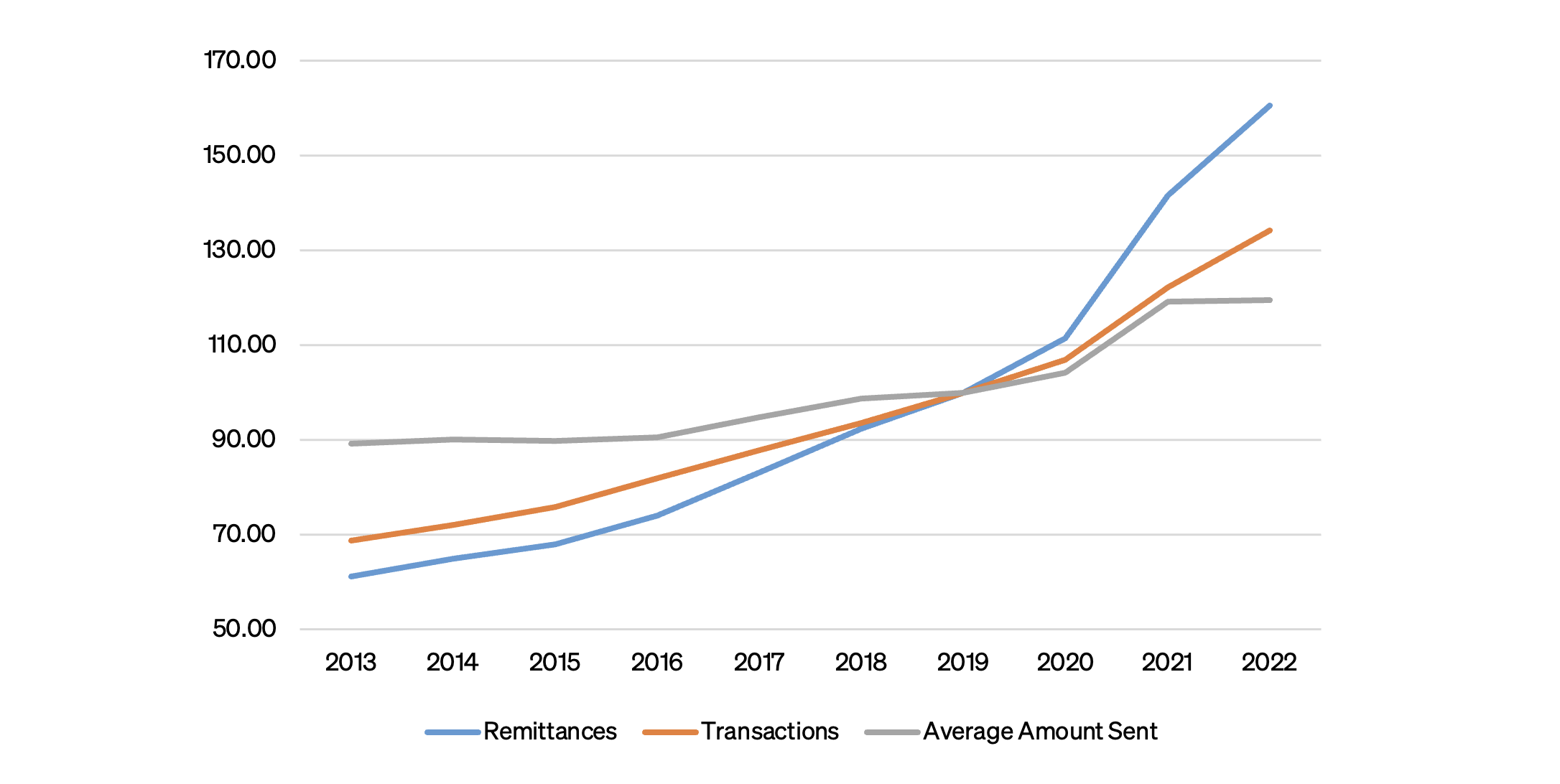
This increase in the number of money transfers may have been due in large part to an increase in the number of people sending remittances to Mexico rather than a rise in the number of new Mexican immigrants arriving in the United States. Additionally, given that many places where remittances are sent in person closed at the beginning of the pandemic, Mexican immigrants had to adapt and make use of digital remittances, which have since grown significantly.
The increase in wages in the United States, due in part to labor shortages during the pandemic, also had a strong impact on remittances. Mexican immigrants were able to establish themselves in better-paying jobs and send more money to their relatives in Mexico. This was likely reinforced by the support from the United States government through unemployment insurance and economic stimulus checks at the beginning of the pandemic. Additionally, as United States labor markets recovered and wages grew toward the end of the pandemic, remittances also continued to increase.[56] However, it is important to mention that the recovery of remittances starting in May 2020 occurred at a stronger pace than could be explained by the recovery in Hispanic unemployment in the U.S. (Figure 13). Starting in 2021, the increase in remittances has depended in part on the lower unemployment of this group in the United States and the improvement in labor markets.
Figure 13 — Remittances to Mexico and Hispanic Unemployment Rate in the United States, Seasonally Adjusted (Millions of Dollars and %), 2017–22
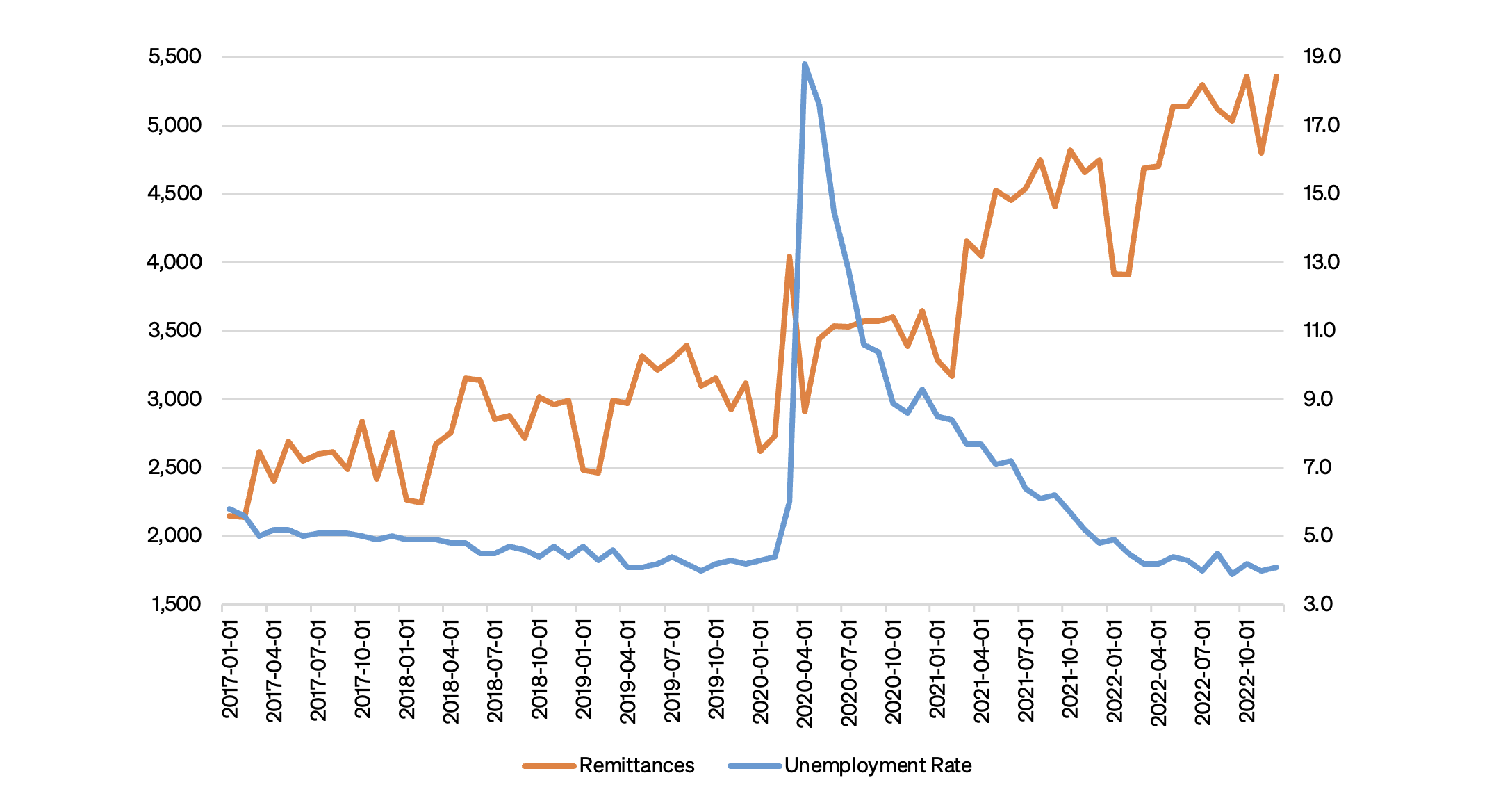
In the medium and long terms, remittances can be expected to continue growing but at decreasing rates. Their growth will depend on the increase in Mexican immigration to the United States in the coming years and the growth of wages for Mexican immigrants. If there are no setbacks and employment and wages remain strong, we can expect the increase in remittances to continue and even reach new records. Furthermore, if the Mexican economy continues to have low levels of growth and generates more poverty in all its dimensions, we can expect that Mexican immigrants in the United States will send more money to their families to help them subsist.
Estimating the growth of remittances and establishing their value in the future is complicated, as previously noted. Some assumptions have to be made to be able to project this value. A simple scenario would be to assume that this growth will be the same or very similar to what has occurred historically. In this case, the behavior of the U.S. and Mexican economies for a certain historical period would be implicit in this assumption, but there could be unforeseen “black swan” events that shift future estimates drastically.
The estimate that will be used for this paper assumes that the total value of remittances sent from the United States is primarily determined by demographic forces. Therefore, remittances can be projected based on per capita terms. That is, remittances divided by the Mexican immigrant population in the United States, it is assumed, will be similar to that seen in the recent past. This creates three potential scenarios.
- Scenario 1: This scenario uses the period from 2010 to 2015 with an average annual per capita growth rate of 3.2% that is assumed to be maintained until 2030.[57] In this case, the total remittances sent from the United States would reach a value of $72.040 billion by 2030.
- Scenario 2: In this scenario, we use the period from 2015 to 2019, before the COVID-19 pandemic, with an average annual per capita growth rate of 10.6%. This implies that the total remittances sent from the United States would be $124.882 billion in 2030.
- Scenario 3: In the third scenario, we use the period from 2010 to 2021 with an average annual per capita growth rate of 8.6%. In this case, the total remittances sent would be around $108.026 billion.
Of these three scenarios, the third one — the period from 2010 to 2021 — likely offers the best estimate due to the fact that it includes years with both low and high emigration. Compared to 2022, it represents a 94% increase in remittances. In fact, all three scenarios lead to the conclusion that remittances will continue to increase into the future, but this increase will depend on the growth of the Mexican immigrant working population and the economies of the United States and Mexico. It can also be assumed that the growth in remittances will continue at a decreasing rate, but some years may still see historic highs.
Conclusion
This analysis reveals that remittances by Mexican immigrant workers in the United States have been a key factor in the Mexican economy for years. Not only do they support and supplement the incomes of households that receive them — especially those in the poorest deciles — but in aggregate, they also promote economic growth and development in recipient states and municipalities. In fact, remittances represent an important inflow of foreign currency to Mexico, even surpassing foreign direct investment and Mexican oil exports in recent years. This has made remittances increasingly important for the Mexican economy.
Mexican immigrant workers have maintained high levels of remittance transfers to their relatives in Mexico for years, in part because they know that their relatives face economic difficulties due to low economic growth in Mexico. To a great extent, this has helped the poorest Mexican households, which are quickly growing in number. In fact, the percentage of people in poverty increased between 2018 and 2020 from 41.9% to 43.9%. In those two years, another 3.8 million Mexicans started experiencing extreme poverty.[58] The only way for this population to survive is by receiving these resources from their relatives abroad.
However, remittances are themselves becoming a strategy of the Mexican government. That is, remittances are presented as if they were an achievement of the government, when obviously they are not. This dependence can be problematic given that these resources are generated by Mexican workers abroad and not by the public policies of the Mexican government.
Assuming that migration from Mexico to the United States continues due to the lack of job opportunities, low salaries, a weak rule of law, and high insecurity in Mexico, remittances are expected to continue rising although at decreasing rates. Of the scenarios established above, considering that the period from 2010 to 2021 offered the best estimate due to the fact that it includes years with both low and high emigration, the total remittances sent from the United States could reach a maximum level of $108.026 billion in 2030. Compared to 2022, this would be a 94% increase. However, it is important to note that this value is a maximum limit, since the growth in remittances is expected to continue at a decreasing rate.
Remittances should be seen as a form of supplemental support that allows Mexican families to purchase necessary goods and services or invest in education and health. Due to the large volume of remittances sent to Mexico, they have had a positive impact on economic growth and development, but the Mexican economy should not solely depend on these resources to continue growing. The best way to have long-term economic growth and development is to invest in physical and human capital. Therefore, better public policies must be designed and established to improve education, health, security, the rule of law, and financial inclusion in Mexico. Remittances must go hand in hand with a better economic strategy that allows Mexico to attract more investment and create jobs to reduce poverty and inequality. This does not mean that remittances shouldn’t be used, but it is important not to solely rely on these resources as a key driver of the Mexican economy.
Given the importance of remittances for the well-being of millions of Mexican families, channels must also be sought to multiply their positive effects. As of now, there are no programs that enhance the effect of remittances for the communities that receive them. The Mexican government must resume programs such as the Three-For-One Collective Remittance Program, which aimed to direct funds toward community projects that generate long-term economic growth and development. In this program, each Mexican peso contributed by migrants was matched by the federal, state, and local governments, multiplying the beneficial impacts for the community.[59] Improving such programs and designing effective measures to encourage and promote better use of these monetary flows should be a priority for Mexican policymakers. Finally, it is important that U.S. and Mexican authorities cooperate with one another and with private institutions to limit organized crime (e.g., money laundering) related to remittance activities.
This paper was originally published in Spanish as a chapter in Revista de Economía Mexicana – Anuario UNAM, published by the Universidad Nacional Autónoma de México.
Notes
[1] KNOMAD-World Bank, “Remittances Brave Global Headwinds,” special focus, Migration and Development Brief 37 (November 2022), https://www.knomad.org/sites/default/files/publication-doc/migration_and_development_brief_37_nov_2022.pdf.
[2] KNOMAD-World Bank, “Remittances Brave Global Headwinds.”
[3] Fundación BBVA Bancomer, A.C. and Consejo Nacional de Població, Anuario de Migración y Remesas México 2022 (July 2022), https://www.bbvaresearch.com/wp-content/uploads/2022/09/Anuario_Migracion_y_Remesas_2022.pdf.
[4] Ralph Chami et al., “¿Son Una Trampa las Remesas?” International Monetary Fund, September 2018, https://www.imf.org/external/pubs/ft/fandd/spa/2018/09/pdf/chami.pdf.
[5] Jose Ivan Rodriguez-Sanchez, “Immigrants in Strategic Sectors of the U.S. Economy and America's Labor Shortage Crisis” (Houston: Rice University’s Baker Institute for Public Policy, June 14, 2022), https://doi.org/10.25613/Y6RY-AY18.
[6] Chami et al., “¿Son Una Trampa las Remesas?”
[7] Adolfo Barajas et al., “Do Workers’ Remittances Promote Economic Growth?” International Monetary Fund, July 2009, https://www.imf.org/external/pubs/ft/wp/2009/wp09153.pdf.
[8] Mohammad Salahuddin and Jeff Gow, “The Relationship Between Economic Growth and Remittances in the Presence of Cross-sectional Dependence,” The Journal of Developing Areas 49, no. 1 (Winter 2015): 207–21, https://www.jstor.org/stable/24241287.
[9] Remittances data was obtained from the Banco de México’s Sistema De Información Económica at https://www.banxico.org.mx/SieInternet/consultarDirectorioInternetAction.do?§or=1&accion=consultarDirectorioCuadros&locale=es.
[10] Comisión Nacional de los Salarios Mínimos, “Incremento a los Salarios Mínimos para 2022,” Gobierno de México, December 1, 2021, https://www.gob.mx/conasami/es/articulos/incremento-a-los-salarios-minimos-para-2022?idiom=es.
[11] Raquel Rosenbloom and Jeanne Batalova, “Mexican Immigrants in the United States,” Migration Policy Institute, October 13, 2022, https://www.migrationpolicy.org/article/mexican-immigrants-united-states.
[12] Rosenbloom and Batalova, “Mexican Immigrants in the United States.”
[13] Rafael López Vega et al., “Índices de intensidad Migratoria México-Estados Unidos 2020,” Consejo Nacional de Población, June 2022, https://www.gob.mx/cms/uploads/attachment/file/789092/IIMMexEEUU2020.pdf.
[14] Instituto Nacional de Estadística y Geografía (INEGI), “Producto Interno Bruto Por Entidad Federativa. Año Base 2013,” https://www.inegi.org.mx/app/tabulados/default.aspx?pr=17&vr=6&in=2&tp=20&wr=1&cno=2.
[15] “División Territorial,” Cuéntame de México, http://cuentame.inegi.org.mx/territorio/division/default.aspx?tema=T.
[16] “Selecciona una Entidad Federativa,” Cuéntame de México, https://cuentame.inegi.org.mx/monografias/default.aspx?tema=me.
[17] Fundación BBVA Bancomer, A.C. and Consejo Nacional de Població, Anuario de Migración y Remesas México 2022.
[18] Fundación BBVA Bancomer, A.C. and Consejo Nacional de Població, Anuario de Migración y Remesas México 2018 (July 2018), https://www.bbvaresearch.com/wp-content/uploads/2018/09/1809_AnuarioMigracionRemesas_2018.pdf.
[19] Fundación BBVA Bancomer, A.C. and Consejo Nacional de Població, Anuario de Migración y Remesas México 2022.
[20] Fundación BBVA Bancomer, A.C. and Consejo Nacional de Població, Anuario de Migración y Remesas México 2022.
[21] Rosenbloom and Batalova, “Mexican Immigrants in the United States.”
[22] Rodriguez-Sanchez, “Immigrants in Strategic Sectors of the U.S. Economy.”
[23] Rosenbloom and Batalova, “Mexican Immigrants in the United States.”
[24] Rosenbloom and Batalova, “Mexican Immigrants in the United States.”
[25] Rosenbloom and Batalova, “Mexican Immigrants in the United States.”
[26] Rosenbloom and Batalova, “Mexican Immigrants in the United States.”
[27] Jesús A. Cervantes González, Denisse Jiménez, and Rodolfo Ostolaza, “Determinantes del Porcentaje de su Ingreso que Envían Como Remesas los Mexicanos Inmigrantes en Estados Unidos a sus Familiares en México,” CEMLA, February 2023, https://www.cemla.org/foroderemesas/notas/2023-03-notas-de-remesas.pdf.
[28] Cervantes González, Jiménez, and Ostolaza, “Determinantes del Porcentaje de su Ingreso que Envían Como Remesas los Mexicanos Inmigrantes en Estados Unidos a sus Familiares en México.”
[29] Juan Jose Li Ng, “Mexico | Does 1 in 5 Pesos of Remittances Come From Mexicans in the Construction Sector?” BBVA Research, January 3, 2022, https://www.bbvaresearch.com/en/publicaciones/mexico-does-1-in-5-pesos-of-remittances-come-from-mexicans-in-the-construction-sector/.
[30] Cervantes González, Jiménez, and Ostolaza, “Determinantes del Porcentaje de su Ingreso que Envían Como Remesas los Mexicanos Inmigrantes en Estados Unidos a sus Familiares en México.”
[31] Cervantes González, Jiménez, and Ostolaza, “La Masa Salarial De Los Trabajadores Mexicanos Inmigrantes En Estados Unidos Alcanzó 283 Mil Millones De Dólares En 2021,” CEMLA, March 2022, https://www.cemla.org/foroderemesas/notas/2022-02-notasderemesas-02.pdf; Cervantes González, Jiménez, and Ostolaza, “Determinantes Del Porcentaje De Su Ingreso Que Envían Como Remesas Los Mexicanos Inmigrantes En Estados Unidos A Sus Familiares En México.”
[32] World Bank, “GDP Growth (Annual %) – Mexico,” https://data.worldbank.org/indicator/NY.GDP.MKTP.KD.ZG?locations=MX.
[33] Enrique Hernández, “Crecimiento Económico Del Gobierno De Amlo Es Muy Bajo, Una Tragedia: Ernesto Revilla,” Forbes, January 6, 2023, https://www.forbes.com.mx/crecimiento-economico-del-gobierno-de-amlo-es-una-tragedia-ernesto-revilla/.
[34] Cervantes González, Jiménez, and Rodolfo Ostolaza, “La Masa Salarial De Los Trabajadores Mexicanos Inmigrantes En Estados Unidos Alcanzó 283 Mil Millones De Dólares En 2021”; Cervantes González, Jiménez, and Ostolaza, “Determinantes Del Porcentaje De Su Ingreso Que Envían Como Remesas Los Mexicanos Inmigrantes En Estados Unidos A Sus Familiares En México.”
[35] Chami et al. “¿Son una trampa las remesas?”
[36] Oded Stark, J. Edward Taylor, and Shlomo Yizhaki, “Migration, Remittances and Inequality,” Journal of Development Economics 28, no. 3 (May 1988): 309–22, https://doi.org/10.1016/0304-3878(88)90002-8; Inayah Hidayati, “Migration and Rural Development: The Impact of Remittance,” IOP Conference Series: Earth and Environmental Science 561, no. 1 (September 2020): 1-6, https://doi.org/10.1088/1755-1315/561/1/012018.
[37] Alina Cazachevici, Tomas Havranek, and Roman Horvath, “Remittances and Economic Growth: A Meta-analysis,” World Development 134 (October 2020), https://doi.org/10.1016/j.worlddev.2020.105021.
[38] Catalina Amuedo-Dorantes, “The Good and the Bad in Remittance Flows,” IZA World of Labor, November 2014, https://wol.iza.org/uploads/articles/97/pdfs/good-and-bad-in-remittance-flows.pdf?v=1.
[39] Barajas et al., “Do Workers’ Remittances Promote Economic Growth?”
[40] Salahuddin and Gow, “The Relationship Between Economic Growth and Remittances.”
[41] Zahid Hussain, “Can International Remittances Be Unproductive in Recipient Countries? Not Really!” End Poverty in South Asia (World Bank blog), February 16, 2014, https://blogs.worldbank.org/endpovertyinsouthasia/can-international-remittances-be-unproductive-recipient-countries-not-really.
[42] Soma Rani Sutradhar, “The Impact of Remittances on Economic Growth in Bangladesh, India, Pakistan and Sri Lanka,” International Journal of Economic Policy Studies 14, no. 1 (January 31, 2020): 275–95, https://doi.org/10.1007/s42495-020-00034-1.
[43] Hector Perez-Saiz et al., “The Impact of Remittances on Economic Activity: The Importance of Sectoral Linkages,” International Monetary Fund, August 16, 2019, https://www.imf.org/en/Publications/WP/Issues/2019/08/16/The-Impact-of-Remittances-on-Economic-Activity-The-Importance-of-Sectoral-Linkages-47091.
[44] Maria Cristina Zhunio, Sharmila Vishwasrao, and Eric P. Chiang, “The Influence of Remittances on Education and Health Outcomes: A Cross Country Study,” Applied Economics 44, no. 35 (December 2012): 4605–16, https://doi.org/10.1080/00036846.2011.593499.
[45] Zhunio, Vishwasrao, and Chiang, “The Influence of Remittances on Education and Health Outcomes.”
[46] Aysen Ustubici and Darja Irdam, “The Impact of Remittances on Human Development: A Quantitative Analysis and Policy Implications,” Economics & Sociology 5, no. 1 (May 20, 2012): 74–95, https://doi.org/10.14254/2071-789X.2012/5-1/6.
[47] Ustubici and Irdam, “The Impact of Remittances on Human Development.”
[48] Amuedo-Dorantes, “The Good and the Bad in Remittance Flows.”
[49] Lidia Carvajal Gutiérrez and Leobardo de Jesús Almonte, “Remesas y Crecimiento: Un Análisis Estructural Para México,” Análisis Económico XXVI, no. 62 (2011): 209–28, https://www.redalyc.org/pdf/413/41319914011.pdf.
[50] Jorge Eduardo Mendoza-Cota and Víctor Hugo Torres-Preciado, “The Impact of Regional Remittances on Economic Growth in Mexico: A Dynamic Space-time Panel Approach,” Papeles de Población 25, no. 101 (2019): 113–44, https://doi.org/10.22185/24487147.2019.101.25; Miguel Ángel Mendoza González and Marcos Valdivia López, “Remesas, Crecimiento y Convergencia Regional en Mexico: Aproximación con un Modelo Panel-espacial,” Estudios Economicos 31, no. 1 (June 2016), https://www.scielo.org.mx/scielo.php?script=sci_arttext&pid=S0186-72022016000100125#fn3.
[51] Miguel D. Ramirez, “Remittances and Economic Growth in Mexico: An Empirical Study with Structural Breaks, 1970–2010,” Business and Economic Research 4, no. 1 (2014), https://digitalrepository.trincoll.edu/cgi/viewcontent.cgi?article=1124&context=facpub.
[52] José Jorge Mora Rivera and Jesús Arellano González, “Las Remesas Como Determinantes del Gasto en las Zonas Rurales de México," Estudios Fronterizos 17, no. 33 (2016): 1–27, https://www.redalyc.org/articulo.oa?id=53043185009.
[53] Pia M. Orrenius et al., “Do Remittances Boost Economic Development? Evidence from Mexican States,” Federal Reserve Bank of Dallas, Working Paper 1007 (October 2010), https://www.dallasfed.org/~/media/documents/research/papers/2010/wp1007.pdf.
[54] Ernesto López-Córdova, Andrea Tokman R. and Eric A. Verhoogen, “Globalization, Migration, and Development: The Role of Mexican Migrant Remittances,” Economía 6, no. 1 (2005): 217–56, https://www.jstor.org/stable/20065489.
[55] Rodriguez-Sanchez, “How Remittances Impact the Economies of Mexican States and Municipalities” (Houston: Rice University’s Baker Institute for Public Policy, November 28, 2022), https://doi.org/10.25613/J3XZ-7P32.
[56] Bureau of Labor Statistics, “Employment Cost Index — December 2022,” news release, July 28, 2023, https://www.bls.gov/news.release/archives/eci_01312023.htm.
[57] To obtain this value in per capita terms, information from the Bank of Mexico is used for remittances, and information from the Migration Policy Institute is used for the Mexican immigrant population in the United States.
[58] CONEVAL (Consejo Nacional de Evaluación de la Política de Desarrollo Social), “Informe de Evaluación de la Política de Desarrollo Social 2022,” February 2023, https://www.coneval.org.mx/Evaluacion/Documents/Informes/IEPDS_2022_Presentacion.pdf.
[59] CONEVAL, “Programa 3 x 1 Para Migrantes,” 2013, https://www.coneval.org.mx/Informes/Evaluacion/Ficha_Monitoreo_Evaluacion_2013/SEDESOL/20_S061.pdf.
This material may be quoted or reproduced without prior permission, provided appropriate credit is given to the author and Rice University’s Baker Institute for Public Policy. The views expressed herein are those of the individual author(s), and do not necessarily represent the views of Rice University’s Baker Institute for Public Policy.



